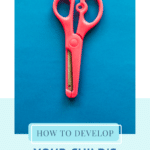Our kids can’t cut. It’s costing us a lot of money. It’s costing them a lot of learning.
Normally, I don’t write articles for the website with lots of citation to research, saving that for journal articles. However, I’ve put some in here because I think it’s important to recognize that this isn’t just my opinion.
If you would like to know how to develop your child’s fine motor skills, you’ve come to the right place. It’s easier to commit to it when you realize how vitally important it is that children have strong fine motor skills.
Are kids really lacking Fine Motor Skills?
At first, I was compelled to look into this issue because of anecdotal stories from teacher friends in early elementary grades who told of a shadow in the East…kids coming to school without fundamental fine motor skills.
They couldn’t cut. They couldn’t hold pencils or even crayons.
Their eyes couldn’t track words across the page.
Then, I started seeing news stories about it from all over the world, not just the United States, but also in Australia and the UK and everywhere else I was reading news.
As a teacher, I know the importance of fine motor skills in class. And even though the articles were focusing on FMS (Fine Motor Skills), I knew that where those were lacking, other necessary skills for learning success probably were as well.
Here are three skill sets necessary for student success in school:
- Fine Motor Skills
- Graphomotor Skills
- Eye Tracking Skills
I’m just writing about FMS today, but I think you know what’s coming.
Is it just the teachers who are noticing?
So, does the research bear out what the teachers are saying? Yep.
At Dublin University’s School of Health a study was done that assessed FMS in 253 kids. They looked at things like shape drawing, lace tying, and pegboard pegging. Their findings were distressing: 36% of the 11- and 12-year olds they tested didn’t meet expected FMS milestones (Issartel, et al, 2017). It’s not just four-year-olds.
Dr. Issartel, who led the study, said, “Not only are children’s physical activity participation and motor skill proficiency levels dropping; children are not developing fine motor skills such as drawing and picking up small objects (e.g coins) like they should. This impacts academic achievement and quality of life both now and in the future. We need to think about how we can tackle this emerging problem before they have long term consequences.”
Another study done in Sri Lanka looked specifically at preschoolers. They found that preschoolers who were on a touch screen more than 60 minutes a week (!) had weaker FMS than their non-touchscreen peers.

One of the issues is that objects on screens aren’t actually real, and kids need to engage in real things (and real people) to learn.
Here is a little excerpt from their findings: “It has been identified that use of touchscreen tablets without interaction with physical objects might be disadvantageous for the fine motor development of preschool children” (Lin et al., 2017).
And it’s not just about reading, either. Pitchford et al (2016) found that FMS were a better predictor of math achievement than reading achievement.
Webster et al (2018) found that preschool-aged children’s manual dexterity skills were inversely related to their screen-time. Inversely related.
The studies, done all over the world, go on and on.
Here’s what they boil down to: Too many kids are being given screens instead of safety scissors, lacing cards, and crayons.
It’s a problem.
Why do children need to cut?
It may not seem like that pair of scissors is that big of a deal, but kids who can’t cut are at a tremendous disadvantage. Read more about that here.
Fine motor skills are important at all ages, and students need practice in developing them. When I wrote an article about things kids should (and shouldn’t) be doing in the summer, I included cutting.

Cutting is powerful – strengthening hand muscles, improving visual-motor skills, developing the idea of directionality, helping the fingers move independently, and leading toward focus and attention.
Hopefully, you’re onboard the FMS train.
What can you do about it?
This is a parent issue and a teacher issue.
I’m sharing actual activities and toys kids can use/play with to develop fine motor skills. These are things that can be done in homes or classrooms (where appropriate). Some of the ideas may be useful to have for indoor recess or for early finishers.
Ideas for developing Fine Motor Skills
Here are some ideas for activities. Some are toys, and some are activities that you can do with things you have (or probably have) in your house.
- Kirigami – like origami, but you cut, not just fold, the paper. Learn more.

- Finger and brush painting (don’t leave out brushes – holding them is critical). You can use Q-tips, too.
- Pattern boards (I like magnetic ones like this.)
- I also like mosaic sticker art kits like this one.
- Playdough (homemade or from the store).
- I like this particular pegboard set because you can string or stack. This is the set I’ve bought for my own grandchild and for Ian Byrd’s son as well.
- String beads on pipe cleaners or shoe laces.
- Lacing beads or lacing cards may not be the most modern of toys, but they’re great for developing FMS, and they have the added benefit of being portable and quiet. You know, for those times.
- Nuts & bolts toys like this one that allow kids to move one hand while holding something in the other are great.
- Pincher toys like this that require kids to grasp and follow with the eye are particularly valuable.
- If you don’t want a whole game, picking up cereal with tweezers works great. This set of kid-friendly tweezers is wonderful.
- Suck up water with an eyedropper or turkey baster.
- Lacing is a critical skill. I like this set because it’s got so many possibilities.
- Sorting anything – pebbles, marbles, coins, anything – is great.
- Busy boards like this buckle toy busy board are great for FMS, but also for helping children develop the skills they need to dress themselves.
- Fingerprint art (get ideas here).
- Putting stickers on stuff. Check out this activity that has shape awareness, too.
Realizing that your older child may need some FMS development, too?
For older kids, consider:
- Light Brite is underrated. You know why? I actually want to play it, too.
- Knitting/crochet (This book for kids is older, but really good.)
- Beading is terrific, and fuse beads add a little extra pizzaz. You can find cool sets like this Harry Potter one.
- Origami or paper plate folding (I LOVE this).
- Puzzles can be one of the most powerful tools in development of fine motor skills. We love them! I usually buy them at Tuesday Morning (or similar store), but if you’re trying to hook a teen or tween on them, grab one that is of something he/she is interested in, like this Broadway Musical puzzle.
- Weaving. I had one of these looms when I was in middle school, and I loved it. Mine was not quite this cool (definitely not anything someone would call “ultimate”). I sold potholders door-to-door to my neighbors for fifty cents! I didn’t know I was improving my Fine Motor Skills, too, but now I feel really virtuous.
- If you have an older child or one who might be interested in different projects, there are more flexible looms that do more than potholders.
- Lego. get a classic set like this one, not a specific kit. One year, my son Joseph wanted a Lego Harry Potter Castle, which was then about $100. He told us that we didn’t have to worry about getting it for him, though, because he had asked Santa. That was a big relief, I can tell you. There is little that will get kids grasping more than those tiny bricks.
- 3d Puzzles. Some are quite pricey, but they do take a long time to do, and you can trade with friends.
- Cooking with you (or alone) develops a lot of skills, and the FMS involved are legion. Don’t stop at getting play food for a play kitchen. Many companies are making real cooking tools that are child-sized, like this set.
I know this is a long list. I’m not saying you need to buy anything. I’m giving you lots of ideas so that you can tune your eye to look at toys and activities through the FMS lens.
When you do, you’ll notice that it’s often a matter of choosing one thing over another, or even just looking around your house to see what you have that your kids could use to work those little
Wrapping Up
Fine Motor Skills are necessary, and they’re fading in our screen-driven world. While it’s easy to just hand a kid a screen, the long-term cost is terrifying.
Consider some of the ideas above, many of which you can do for absolutely free.
The bottom line is that as parents we have to make sure kids are engaged in more fine motor tasks that just tapping and swiping, and as teachers, we have to make sure parents understand why it’s important.
You May Also Like:
- 6 Reasons Not to Give IQ Tests to Young Children
- 7 Picture Books for Bright Readers
- Why Students Need Less Leadership and More Followship
Would you like to join thousands of other cool people and receive my free monthly newsletter? Sign up and receive a free guide for helping gifted children thrive in school.

Note: Sometimes I use affiliate links, which means that if you click through and buy something, I get a few pennies (to buy more books!). It will never cost you anything extra.





















